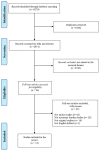Economic Burden of Stroke Disease: A Systematic Review
- PMID: 34299999
- PMCID: PMC8307880
- DOI: 10.3390/ijerph18147552
Economic Burden of Stroke Disease: A Systematic Review
Abstract
Globally, one of the main causes of non-communicable disease as a cause of death every year is stroke. The objective of this study was to analyze the burden in consequence of stroke. This research used a systematic review method. Furthermore, a search for articles was carried out in June-July 2020. Four databases were used to search articles from 2015 to 2020. Eligible studies were identified, analyzed, and reported following the Preferred Reporting Items for Systematic Reviews and Meta-Analysis (PRISMA) guidelines. The inclusion criteria were prospective cost studies, retrospective cost studies, database analysis, mathematical models, surveys, and COI studies that assess burden of stroke in primary and referral healthcare (hospital-based). The results showed that from four databases, 9270 articles were obtained, and 13 articles were qualified. A total of 9270 articles had the identified search keywords, but only 13 articles met the set criteria for inclusion. The criteria for inclusion were stroke patients, the economic burden of stroke disease based on cost of illness method, which is approximately equal to USD 1809.51-325,108.84 (direct costs 86.2%, and indirect costs 13.8%). Those that used the health expenditure method did not present the total cost; instead, only either direct or indirect cost of health expenditure were reported. For most hospital admissions due to stroke, LOS (length of stay) was the dominant cost. The high economic burden to manage stroke justifies the promotion and preventive efforts by the policymakers and motivates the practice of healthy lifestyles by the people.
Keywords: cerebrovascular accident; economic burden of disease; length of stay; stroke.
Conflict of interest statement
The authors declare no conflict of interest.
Comment in
-
Comment on Rochmah et al. Economic Burden of Stroke Disease: A Systematic Review. Int. J. Environ. Res. Public Health 2021, 18, 7552.Int J Environ Res Public Health. 2022 Mar 30;19(7):4095. doi: 10.3390/ijerph19074095. Int J Environ Res Public Health. 2022. PMID: 35409776 Free PMC article.
-
Reply to Shaikh et al. Comment on "Rochmah et al. Economic Burden of Stroke Disease: A Systematic Review. Int. J. Environ. Res. Public Health 2021, 18, 7552".Int J Environ Res Public Health. 2022 Apr 2;19(7):4261. doi: 10.3390/ijerph19074261. Int J Environ Res Public Health. 2022. PMID: 35409943 Free PMC article.
References
-
- World Health Organization . Monitoring Health for The SDGs. Volume 15 World Health Organization; Geneva, Switzerland: 2018.
-
- The George Institute for Global Health . Reducing the Burden of Cardiovascular Disease in Indonesia. The George Institute for Global Health; Sydney, Australia: 2017.
-
- Kementerian Kesehatan . Laporan Tahunan Badan Penelitian Dan Pengembangan Kesehatan 2019. Kementerian Kesehatan Republik Indonesia; Jakarta, Indonesia: 2019.
-
- Johnson A.J., Dudley W.N., Wideman L., Schulz M. Physiological Risk Profiles and Allostatic Load: Using Latent Profile Analysis to Examine Socioeconomic Differences in Physiological Patterns of Risk. Eur. J. Environ. Public Health. 2019;3:2–9. doi: 10.29333/ejeph/5870. - DOI
Publication types
MeSH terms
LinkOut - more resources
Full Text Sources
Medical
Miscellaneous


